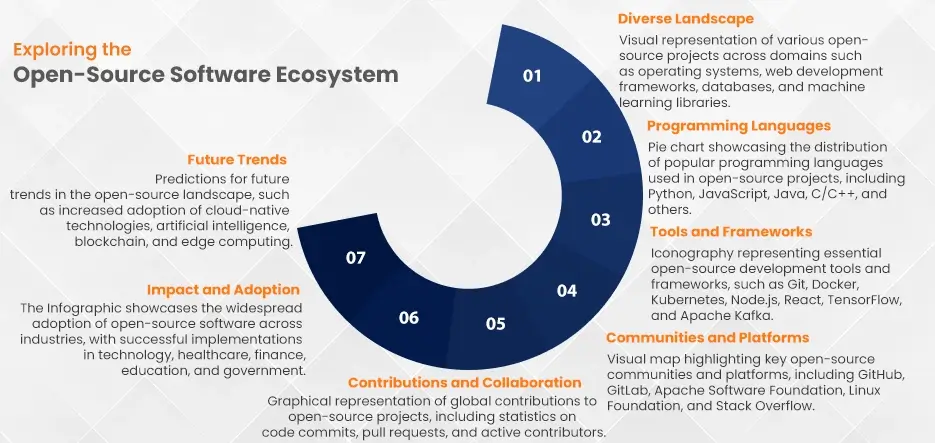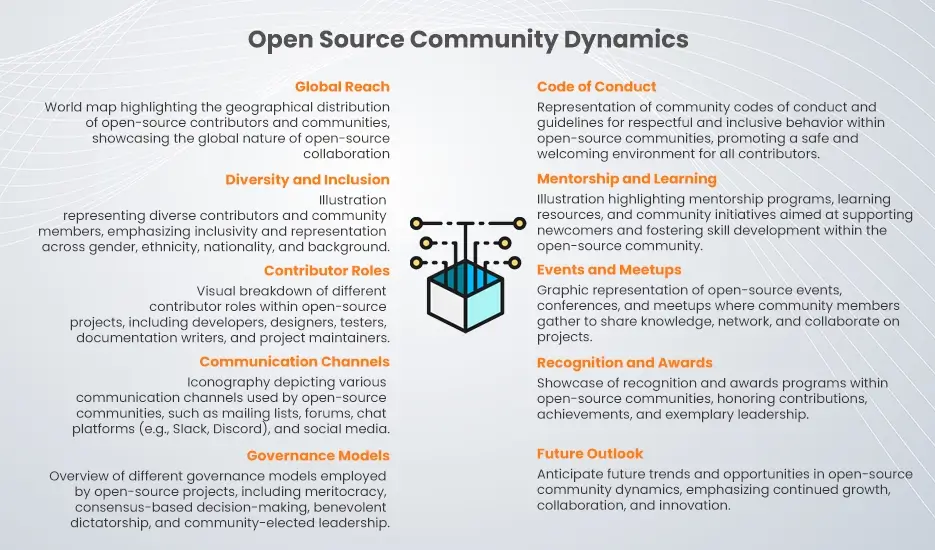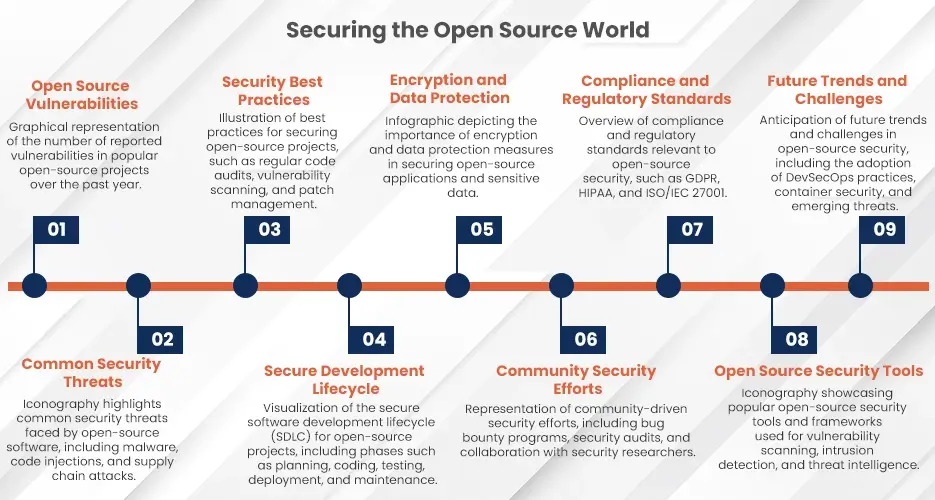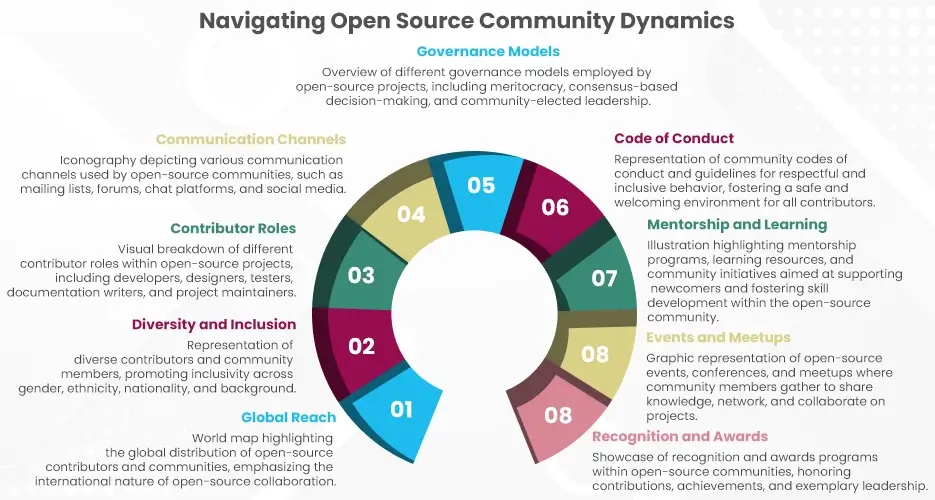Table of Contents
Open-source software (OSS) has arisen as a power in the domain of software development, significantly impacting development communities worldwide. By fostering collaboration, innovation, and inclusivity, open-source software has revolutionized how developers work, team up, and make software solutions. The global open-source software market is expected to reach $32.95 billion by 2027, growing at a CAGR of 15.6% from 2020 to 2027. The significant effect of open-source software on development communities focuses on the themes of collaboration and innovation.
Facts and Data:
- According to a report by The Linux Foundation, open-source software controls more than 80% of websites universally, highlighting its far and wide adoption and influence in the computerized landscape.
- GitHub, one of the biggest platforms for open-source collaboration, has north of 200 million storehouses and flaunts a community of more than 56 million developers effectively contributing to open-source projects.
- The Territory of Open Source Study 2023 uncovered that 94% of respondents consider open-source software essential to their association’s infrastructure and development technique, underscoring its importance in current software development practices.
As development communities increasingly go to open-source solutions, the effect of OSS reaches out past mechanical innovation to envelop social movements, monetary ramifications, and cultural benefits. The cooperative idea of open source collaboration software engages developers to cooperate, share knowledge, and expand upon one another’s commitments, transcending geological limits and authoritative barriers.
Also, the effect of open-source software reaches out past the domain of technology to include more extensive social and monetary aspects. The demand for open-source skills is growing rapidly, with job postings for positions requiring open-source expertise increasing by 25% annually. By democratizing access to software tools and resources, open-source software catalyzes monetary development, business ventures, and social innovation on a worldwide scale.
Looking for a Tech Upgrade? Let’s Build Your Next Software Solution Together!
Understanding Open-Source Software (OSS)
Understanding Open-Source Software (OSS) involves grasping the principles, characteristics, and ramifications of software that is freely available for use, modification, and distribution by anybody. Here is a breakdown of key perspectives:
Definition
Open-source software alludes to software whose source code is made available to the public under a permit that awards users the option to use, change, and distribute the software freely. The global open-source software market was valued at $11.4 billion in 2020, and it is expected to reach $32.95 billion by 2027, growing at a CAGR of 15.6% from 2020 to 2027. (Source: Fortune Business Insights). The source code is the intelligible type of the program that developers compose and alter.
Licensing
Open-source licenses direct the terms under which the software can be used, changed, and distributed. Open source development licenses change concerning consents, limitations, and necessities, yet they for the most part permit users to access, change, and redistribute the software without charging a licensing expense.
Characteristics
- Accessibility: Open-source software is freely accessible to anybody with an internet association.
- Transparency: The source code is available for inspection, allowing users to understand how the software functions and make modifications depending on the situation.
- Community-driven: Many open-source projects are maintained and improved by a community of developers who team up and add to the software’s development.
- Flexibility: Users can change the software to suit their particular necessities, making it profoundly versatile to different use cases.
- Security: While open-source software is dependent upon public scrutiny, which can improve security through peer review, weaknesses can likewise be distinguished and taken advantage of while perhaps not appropriately made due.
- Cost-effectiveness: Since open-source software is normally free, it can essentially lessen licensing costs for individuals and organizations.
Examples: A Few Notable Examples of Open-source Software Include
- Operating systems: Linux, FreeBSD
- Web servers: Apache HTTP Server, Nginx
- Web browsers: Mozilla Firefox, Chromium (the open-source project behind Google Chrome)
- Content Management Systems (CMS): WordPress, Drupal
- Programming languages and frameworks: Python, PHP, Ruby on Rails

The Evolution of Open-Source Development Communities
The evolution of open-source development communities follows a rich history of collaboration, innovation, and change in software development. Here is a breakdown of key stages and perspectives:
1. Foundations of Open Source
- The Free and best open source software for business, initiated by Richard Stallman in the 1980s, laid the philosophical foundation for open-source development.
- Stallman’s GNU Project aimed to make a free, Unix-like operating system, promoting the principles of software freedom and user independence.
2. Emergence of Linux and GNU/Linux
- Linus Torvalds’ production of the Linux piece in 1991 denoted a crucial crossroads in open-source history.
- Linux, combined with GNU utilities and other open-source parts, framed the premise of the GNU/Linux operating system, which gained prevalence in the 1990s.
3. Rise of the Internet and Collaboration Tools
- The boundless adoption of the Internet in the 1990s revolutionized open-source development by facilitating worldwide collaboration and correspondence.
- Version control systems like CVS, Disruption, and later Git, furnished developers with tools for managing and coordinating code commitments.
4. Foundations and Organizations
- The Open Source Initiative (OSI), established in 1998, formalized the definition and principles of open-source software through the Open Source Definition and the endorsement of open-source licenses.
- The Apache Software Foundation laid out in 1999, turned into a prominent association fostering open-source projects, including the Apache HTTP Server and Apache Tomcat.
5. Diversity and Specialization
- Open-source development communities include a different scope of projects, spanning operating systems, web servers, programming languages, and applications.
- Particular communities arise around unambiguous technologies, industries, and domains, fostering innovation and ability.
6. Corporate Involvement and Sponsorship
- Numerous technology organizations, including Google, IBM, Microsoft, and Red Cap, effectively add to open-source projects and support community occasions and initiatives.
- Corporate involvement brings financial resources, skill, and authenticity with the advantages of open source software while raising questions about governance and community independence.
7. Global Impact and Collaboration
- Open-source development rises above geological limits, enabling collaboration among developers and organizations worldwide.
- Projects like Wikipedia, Mozilla Firefox, and Kubernetes exhibit the worldwide reach and effect of open-source initiatives.
Collaboration in Open-Source Projects: Principles and Practices
Collaboration in open-source projects is directed by principles and practices that underscore transparency, inclusivity, and community-driven development. Here is an outline of key principles and practices:
1. Transparency
- Open-source projects work directly, with source code, conversations, and open source software security risks and best practices for decision-making processes open to the public.
- According to the 2023 Open Source Security and Risk Analysis (OSSRA) report, open-source components make up 75-90% of the codebases analyzed in commercial applications. (Source: Synopsys). Transparency encourages trust among contributors and enables accountability within the community.
2. Inclusivity
- Open-source projects invite commitments from developers of all foundations, expertise levels, and experience levels.
- Inclusivity advances diversity of viewpoints, encourages innovation, and improves the community.
3. Meritocracy
- Open-source communities frequently work on a meritocratic premise, where commitments and decisions depend on legitimacy, mastery, and exhibited skill.
- Meritocracy empowers dynamic support, rewards important commitments, and guarantees the quality of the project.
4. Decentralized Decision-Making
- Decision-making in open-source projects is decentralized, with commitments and criticism requested from the community.
- Conversations normally occur in public gatherings, mailing records, with agile software development life cycles, issue trackers, or cooperative platforms like GitHub.
5. Code Review and Quality Assurance
- Open-source projects depend on code review cycles to maintain code quality, distinguish messes, and guarantee compliance with project standards.
- Peer review by community individuals helps make mistakes, improve code comprehensibility, and divide knowledge between contributors.

Innovation Through Open-Source: Contextual Investigations and Examples of Overcoming Adversity
Innovation through open source has prompted various contextual analyses and examples of overcoming adversity across different industries and domains. Here are a few examples that feature the groundbreaking effect of open-source software initiatives:
1. Linux Operating System
Linux, one of the most prominent open-source projects, drives a critical part of the world’s computing infrastructure. Initially created by Linus Torvalds in 1991, Linux has developed into a robust and adaptable operating system used in servers, implanted gadgets, and supercomputers. Open-source software contributes an estimated $447 billion to the global economy annually. For every dollar invested in open-source development, it generates approximately $1.50 in value for the broader economy. Its cooperative development model and open-source licensing have encouraged innovation, security, and soundness, making it a favored decision for custom software development consulting and organizations worldwide.
2. Apache HTTP Server
The Apache HTTP Server, an open-source web server software, dominates the web server market, serving a large number of websites internationally. Created by the Apache Software Foundation, the project represents the force of community-driven development and collaboration. The Apache Software Foundation, one of the largest open-source communities, manages over 200 projects and has more than 7,000 individual members and 81 corporate sponsors. Its flexibility, extensibility, and security highlights have made it a foundation of the Internet infrastructure, driving innovation in web hosting and server technologies.
3. Mozilla Firefox Web Browser
Mozilla Firefox, an open-source web browser, arose as a challenger to dominant proprietary browsers in the mid-2000s. Created by the Mozilla Foundation, Firefox focuses on user privacy, security, and customization through its open-source model. Its prosperity has prodded contest and innovation in the browser market, improving standards compliance, performance, and user experience.
4. Android Mobile Operating System
Android, an open-source mobile operating system created by Google, drives most smartphones and tablets worldwide. Its open-source nature enables gadget makers and developers to alter and expand the platform, driving innovation in mobile applications and administrations. Android’s far-reaching adoption has democratized access to mobile technology, fostering business ventures, and monetary development in emerging business sectors.
5. WordPress Content Management System (CMS)
WordPress, an open-source CMS, powers many websites, web journals, and online stores worldwide. Its user-accommodating interface, broad plugin ecosystem, and energetic community have democratized content creation and publishing. WordPress’ open-source model enables developers to contribute themes, plugins, and improvements, driving innovation in web plans, online business, and computerized publishing.
6. Kubernetes Container Orchestration
Kubernetes, an open-source container orchestration platform created by Google, works on the organization, scaling, and management of containerized applications. Its adaptable design and rich ecosystem of tools have sped up the adoption of container technologies and microservices structures. Kubernetes has turned into the accepted standard for container orchestration, enabling organizations to assemble and work with adaptable, versatile, and cloud-native applications.
These contextual investigations exhibit how open-source initiatives have powered innovation, collaboration, and mechanical progression across different domains, shaping the advanced landscape. Empowering individuals, businesses, and communities worldwide.
Empower Your Business with Cutting-Edge Software. Request a Free Consultation Today!
The Role of Licensing in Open-Source Software
The role of licensing in open-source software is central to defining the terms of use, distribution, modification, and redistribution of software code. Licensing lays out the legal system within which open-source projects work and oversees the limitations of users, contributors, and redistributors. Here are key parts of the role of licensing in open-source software:
1. Freedom of Use
Open-source licenses award users the freedom to use the software for any reason, whether individual, commercial, or non-benefit, without imposing prohibitive utilization conditions or expenses.
2. Modification and Redistribution
Open-source licenses permit users to alter the source code of the software and redistribute the adjusted adaptations under similar agreements. This energizes collaboration, innovation, and the sharing of improvements within the open-source community.
3. Distribution and Access
Open-source licenses expect that the source code of the software be made available to users alongside the arranged binaries. This guarantees transparency, cultivates trust, and engages users to understand how the software functions and pursue informed choices.
4. Permissive vs. Copyleft Licenses
Permissive Licenses: Permissive licenses, for example, the MIT Permit and the Apache Permit, permit users to alter and redistribute the software under practically any terms, including proprietary licenses. It underscores freedom and flexibility while preserving the open-source nature of the software.
Copyleft Licenses: Copyleft licenses, for example, the GNU, expect that subordinate works and modifications of the software be distributed under the equivalent copyleft permit terms. Copyleft licenses aim to safeguard the openness and freedom of the software codebase and forestall its allotment by proprietary interests.
5. Compatibility and Interoperability
Open-source licenses might differ regarding compatibility with other licenses and frameworks. Projects should consider permit compatibility while incorporating code from outsider libraries or conditions to guarantee legal compliance and interoperability.
6. Community Governance and Enforcement
Open-source projects might lay out governance models and components for enforcing permit compliance and resolving debates. Community-driven enforcement endeavors aim to maintain the integrity of open-source licenses and safeguard the privileges of contributors and users.
7. Legal Protections and Liabilities
Open-source licenses give legal protections to the two users and contributors by specifying the terms of responsibility, guarantee, and indemnification. Users are ordinarily furnished with software “with no guarantees,” without guarantees, while contributors might disclaim responsibility for any harms arising from the use of the software in digital transformation in healthcare.
Licensing assumes an essential part in defining the privileges, commitments, and freedoms related to open-source software, shaping the cooperative and straightforward nature of open-source development, and ensuring the drawn-out sustainability and accessibility of software projects. Choosing a suitable open-source permit is fundamental for maintaining integrity, and inclusivity. The openness of the software codebase while promoting innovation and community engagement.

Challenges and Solutions in Open-Source Development Communities
Open-source development communities face different challenges that originate from the decentralized and cooperative nature of open-source projects. Nonetheless, these challenges likewise present opportunities for innovation and improvement. Here is an outline of normal challenges and likely solutions in open-source development communities:
1. Fragmentation and Divergence
Challenge: Open-source projects might become divided, with numerous forks and disparate codebases, leading to compatibility issues and duplication of endeavors.
Solution: Lay out clear project governance structures and correspondence channels to cultivate collaboration, agreement building, and coordination among contributors. Support a combination of endeavors and intermingling towards shared objectives and standards.
2. Sustainability and Funding
Challenge: Many open-source projects battle to tie down sustainable funding and resources to help with ongoing development, maintenance, and infrastructure costs.
Solution: Investigate different funding models, like corporate sponsorship, gifts, awards, and crowdfunding campaigns. Implement financial management practices and look for associations with enterprise software development companies focused on supporting open-source initiatives.
3. Contributor Burnout and Turnover
Challenge: Contributors to open-source projects might encounter burnout because of overcommitment, lack of recognition, and conflicting priorities.
Solution: Encourage a steady and inclusive community culture that qualities and acknowledges commitments, everything being equal. However, support balance between fun and serious activities, give mentorship and expert development opportunities and perceive contributors’ accomplishments through identifications, grants, and public affirmations.
4. Maintainer and Leadership Burden
Challenge: Project maintainers and pioneers frequently bear critical obligations regarding code review, issue emergencies, documentation, and decision-making, leading to burnout and bottlenecks.
Solution: Distribute leadership roles and responsibilities across the community, engage contributors to take responsibility for regions or initiatives, and cultivate a culture of shared proprietorship and accountability. Furthermore, give mentoring and backing to emerging pioneers and energize leadership progression planning.
5. Security and Vulnerability Management
Challenge: Open-source projects might be susceptible to security weaknesses, code exploits, and store network assaults because of the distributed and cooperative nature of development.
Solution: Implement robust security practices, including code review, vulnerability scanning, automated testing, and opportune security refreshes. However, encourages a culture of security mindfulness and proactive gamble management among contributors with digital transformation services. Draw in with security scientists and bug abundance projects to proactively recognize and address weaknesses.
6. Diversity and Inclusion
Challenge: Open-source communities might lack diversity and inclusion, leading to bias, discrimination, and exclusionary practices.
Solution: Cultivate a welcoming and inclusive community culture that values diversity of foundations, viewpoints, and encounters. Implement inclusive language and conduct approaches, give diversity and inclusion training, and effectively enroll and guide underrepresented bunches in technology. Moreover, it makes places of refuge and encourages groups of people for marginalized individuals to contribute and flourish in open-source environments.
7. Documentation and Onboarding
Challenge: Inadequate documentation and onboarding cycles might hinder new contributors from understanding project objectives, codebase construction, and commitment guidelines.
Solution: Focus on documentation as a top-notch resident in the development cycle, providing thorough aides, instructional exercises, and Programming interface references. However, implement user-accommodating onboarding tools and platforms, for example, issue layouts, contributor directs, and automated arrangement scripts. Offer mentoring and support for novices, and cultivate a culture of persistence, sympathy, and collaboration among community and healthcare software development companies.
Addressing challenges in open-source development communities requires proactive engagement, collaboration, and continuous improvement across specialized, social, and authoritative aspects. By fostering a culture of transparency, inclusivity, and sustainability, open-source projects can beat impediments, drive innovation, and enable individuals and communities to make effective software solutions for the benefit of society.
Ready to Build? Let’s Create Your Software Solution Today!
Diversity and Inclusivity in Open-Source Communities
Diversity and inclusivity in open-source communities are basic for fostering innovation, collaboration, and the drawn-out sustainability of projects. Therefore, these principles guarantee that open-source software mirrors the requirements, points of view, and commitments of a different scope of individuals and communities. Here is a clarification of diversity and inclusivity in open-source communities:
1. Diversity
Diversity envelops various aspects, including but not restricted to race, identity, orientation, sexual direction, age, financial status, ethnicity, religion, handicap, and geographic area. However, embracing diversity brings together individuals with various foundations, encounters, and viewpoints, enriching the community and enhancing imagination, critical thinking, and decision-making.
2. Inclusivity
Inclusivity alludes to creating environments where all individuals feel appreciated, regarded, and esteemed, no matter what their experience or personality. However, inclusive communities effectively look to eliminate barriers, biases, and discrimination that might forestall marginalized or underrepresented bunches from completely participating and contributing to open-source projects.
3. Importance of Diversity and Inclusivity
Innovation: Diversity encourages innovation by bringing together individuals with different points of view, knowledge, and mastery. Various groups are bound to produce original thoughts, distinguish alternative solutions, and address complex challenges.
Representation: Inclusive communities guarantee that the voices and encounters, everything being equal, including those from marginalized or underrepresented gatherings, are heard, esteemed, and addressed in decision-making cycles and project results.
4. Challenges and Barriers
Bias and Discrimination: Certain biases and discriminatory mentalities might appear in language, conduct, and decision-making processes within open-source communities, leading to prohibition and marginalization.
Lack of Representation: A few gatherings, like ladies, minorities, and individuals from underrepresented locales or financial foundations, may confront systemic barriers and lack representation in open-source communities.
5. Strategies for Promoting Diversity and Inclusivity
Cultivate Inclusive Culture: Encourage a culture of regard, sympathy, and collaboration within open-source communities. However, it empowers undivided attention, useful criticism, and shared help among individuals.
Outreach and Engagement: Proactively connect with underrepresented gatherings and invite them to take part in open-source projects. Make welcoming spaces and mentorship projects to install and support novices.
Diversity and inclusivity are major qualities that drive open-source communities’ prosperity, resilience, and effect. However, by embracing diversity and fostering inclusivity, open-source projects can saddle the aggregate gifts, imagination, and commitments of a worldwide community to construct more innovative, accessible, and even-handed software solutions for the benefit of all.
Open-source Software in Enterprise Environments
Open-source software has become increasingly predominant in enterprise environments because of its various benefits, including flexibility, cost-effectiveness, security, and innovation. However, this is a clarification of the way open-source software is used in enterprise environments:
1. Cost-Effectiveness
One of the essential drivers behind the adoption of open-source software in enterprises is cost-effectiveness. However, dissimilar to proprietary software, open-source solutions commonly don’t need licensing charges, which can prompt massive cost savings for custom software development outsourcing, particularly for huge-scope arrangements.
2. Flexibility and Customization
Open-source software furnishes enterprises with more noteworthy flexibility and customization choices contrasted with proprietary solutions. Furthermore, organizations can change the source code to meet their particular prerequisites, integrate with existing systems, and tailor the software to suit their exceptional business processes.
3. Security and Transparency
Open-source software is frequently seen as safer because of its straightforward nature. However, with access to the source code, enterprises can direct security reviews, distinguish weaknesses, and implement essential security measures to safeguard their systems and data. Furthermore, open-source communities effectively team up to address security issues and deliver fixes and updates instantly.
4. Innovation and Collaboration
Open-source communities encourage a culture of innovation and collaboration, where developers, users, and organizations contribute code, share best practices, and drive continuous improvement. However, by leveraging the aggregate aptitude of the community, enterprises can access cutting-edge technologies, remain in front of industry trends, and innovate all the more quickly.
5. Vendor Neutrality and Independence
Open-source software diminishes vendor lock-in and dependency on unambiguous vendors or proprietary technologies. Additionally, enterprises have the freedom to browse a large number of open-source solutions, switch between suppliers, and try not to be attached to a single vendor’s ecosystem or item guide.
6. Scalability and Performance
Many open-source solutions are intended to be exceptionally adaptable and performant, making them appropriate for enterprise-scale organizations and crucial applications. Additionally, open-source technologies like databases, web servers, and cloud platforms offer robust performance, scalability, and unwavering quality to meet the demanding necessities of enterprise environments.

Future Trends and Opportunities in Open-Source Development
Future trends and opportunities in open-source development mirror the evolving landscape of technology, innovation, and collaboration. However, as open source continues to gain energy and influence across industries, a few critical trends and opportunities are shaping the future of open-source development:
1. Decentralized and Distributed Collaboration
With the ascent of remote work and distributed groups, open-source development is becoming more decentralized and inclusive. Cooperative tools and platforms enable contributors from around the world to team up on projects, share knowledge, and contribute skills, paying little heed to geographic areas with artificial intelligence in software development.
2. Emerging Technologies and Domains
Open source is driving innovation in emerging technologies and domains, for example, artificial intelligence, machine learning, blockchain development, edge computing, and the Internet of Things (IoT). Open-source projects act as incubators for trial and error, examination, and development of new technologies, fostering cross-industry collaboration and accelerating adoption.
3. Security and Privacy
As cybersecurity dangers continue to develop, open source assumes an urgent part in enhancing security and privacy across software ecosystems. Open-source security tools, frameworks, and best practices assist organizations with mitigating gambles, distinguishing weaknesses, and safeguarding sensitive data. However, collaborative efforts to improve security and privacy standards benefit the entire open-source community.
4. Open Data and Open Science
Open-source principles are extending past software to incorporate open data and open science initiatives. Open data projects advance transparency, reproducibility, and accessibility of exploration data, facilitating logical collaboration and innovation. Open-source tools and platforms enable scientists, scholastics, and institutions to share data, distribute findings, and team up on interdisciplinary projects.
5. Community Sustainability and Governance
Sustainable community models and governance structures are fundamental for the drawn-out practicality of open-source projects. However, initiatives focused on funding, resource distribution, and contributor support are addressing challenges connected with sustainability, diversity, and inclusion in open-source communities. Moreover, cooperative endeavors to foster accepted procedures and standards for community governance to advance transparency, accountability, and resilience.
6. Artificial Intelligence and Automation
Open source is driving headways in artificial intelligence (AI) and automation through projects like TensorFlow, PyTorch, and scikit-learn. Moreover, open-source libraries, frameworks, and tools democratize access to AI technologies, enable developers to fabricate intelligent applications, and speed up innovation in machine learning, natural language processing, computer vision, and robotics.
7. Cloud-Native and DevOps Practices
Cloud-native technologies and DevOps practices are reshaping software development and sending strategies. Therefore, open-source projects like Kubernetes, Docker, and Prometheus enable organizations to fabricate, send, and oversee versatile, strong, and cloud-native applications. However, collaboration within custom software development for startups and the open-source community drives standardization, interoperability, and best practices for cloud-native structures.
8. Regulatory Compliance and Governance
Increasing regulatory prerequisites and compliance standards require robust governance and accountability systems in open-source projects. Therefore, initiatives focused on permit compliance, intellectual property management, and legal frameworks assist organizations with navigating legal and regulatory challenges in open-source software development. Collaboration between industry partners, legal specialists, and backing bunches advances transparency, risk management, and regulatory compliance.
Future trends and opportunities in open-source development mirror the dynamic and evolving nature of technology, innovation, and collaboration. Additionally, by embracing emerging trends, addressing challenges, and seizing opportunities, open-source communities can continue to drive progress, cultivate innovativeness, and have a constructive outcome on the world. However, collaboration, transparency, and inclusivity remain at the center of open-source development, shaping the future of technology for a long time into the future.
Transform Your Software Vision into Reality – Book a 30-Minute Free Consultation!
Conclusion: Embracing Collaboration and Innovation in Open-Source Software
In conclusion, embracing collaboration and innovation in open-source software isn’t simply a best practice; it’s a foundational principle that drives progress, cultivates imagination, and enables communities worldwide. However, over 80% of websites globally use open-source software for various components of their infrastructure, including web servers, databases, content management systems, and programming languages. However, open-source software epitomizes the force of aggregate intelligence, where individuals from assorted foundations and mastery meet up to take care of issues, construct effective solutions, and shape the future of technology.
FAQs: Got Questions? We’ve Got Answers!
1. What is Open Source Software?
Open source software alludes to software that is made out of code that is freely accessible, visible and usable by anybody, without limitations. Therefore, it enables users to have the freedom to access, alter, and distribute the source code of the software. Therefore, the open nature of the software supports knowledge sharing and drives mechanical innovation within the software community. Additionally, by allowing users to add to and improve the software, open-source software has turned into a strong power in advancing technology.
2. Is Open Source Software Free?
Open source software is by and large available for free, albeit this isn’t generally the situation. However, many open source software programs are accessible to the public with no charges, there are instances where certain open source software might require an expense. Therefore, extra administrations, for example, backing or bug-fixing related to open source software could include some significant pitfalls. Therefore, while the open-source software itself might be free to obtain, accessing the full scope of benefits and functionalities could involve an additional expense for custom software development services.
3. Could Open Source Software Be Used for Commercial Purposes?
Indeed, open source software can be used for commercial purposes and has been instrumental in creating a tremendous measure of technology that is sold commercially. Additionally, its temperament, open source can be used and distributed freely, so open source software is frequently used by developers to assemble proprietary software that is sold for commercial purposes. However, many organizations likewise make a commercial gain from charging for extra elements that supplement free open-source code, for example, support administrations.
4. What is The Difference Between Proprietary and Open Source Software?
With proprietary software, the software source code is left well enough alone, meaning it’s not accessible to the public. However, open-source software makes the source code available for everybody to see, alter, and distribute as they wish. Therefore, it is critical to take note that various kinds of open source software might accompany certain principles, for example, copyleft open source software. Therefore, with regards to proprietary software, custom software development for startups doesn’t approach the source code and is generally expected to buy licenses for its use. Proprietary software frequently offers specific elements and backing yet lacks the openness and customization choices of open-source software.
5. What is Copyleft Open Source Software?
Copyleft open-source software is a remarkable kind of software permit that permits individuals to use, change, and distribute the open source software. However, there is a significant condition: any work made using the copyleft open-source software should likewise be authorized under similar terms. This implies that others are allowed the freedom to use, change, and distribute the work made using the copyleft open-source software. The motivation behind keeping it open is to advance collaboration and urge making improvements to the original open-source software. Therefore, Copyleft licensing additionally keeps the open-source software from being made proprietary or shut off from the tech community.
6. What are The Benefits of Open Source Software?
Open-source software enjoys a few benefits and has been instrumental in developing a significant part of the technology we use consistently.
Firstly, open-source software is accessible to the public to be used, adjusted, and shared, which drives the innovation of new technologies. This implies you can use existing software solutions with minimal costs.
Secondly, open-source software is used by the software community to construct and share knowledge about open-source software.
Thirdly, open source software offers flexibility as it may very well be altered to meet explicit custom software development services needs, giving organizations more prominent command over their software infrastructure. This lessens reliance on outsider software suppliers that permit proprietary software. Therefore, open-source software engages users to access cost-successful, nimble, and community-driven solutions.






